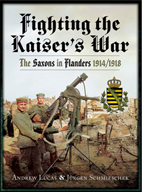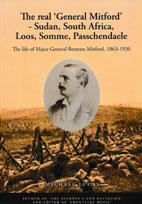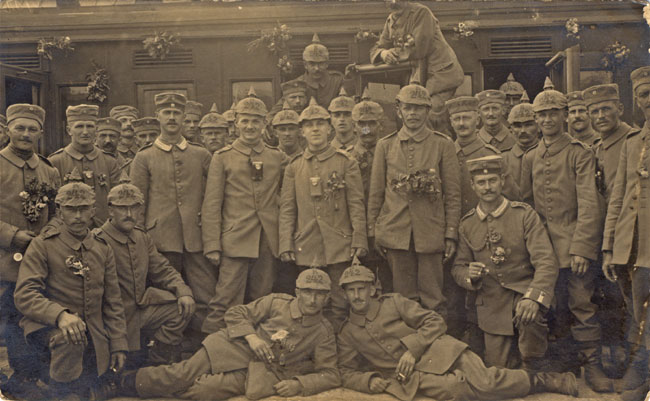On 25th October 1914, Einjährig-Freiwilliger Curt Penther of 6. Kompagnie / Reserve-Infanterie-Regiment Nr.242 (53. Reserve-Division / XXVII. Reservekorps) took part in the regiment's first full-scale assault against the British defensive positions on the Menin Road, at the village of Kruseik.
Wounded a week later, he subsequently described his experiences in a letter from hospital to his sweetheart - who had perhaps already seen local newspaper coverage of his regiment's bloody ordeal.

Reservelazarett II. Abt. 3 Groß-Auheim, near Hanau am Main, 10th November 1914
My dear Martha!
You would scarcely believe how hard it is for me to write. I can't hold the paper still, my left hand is abominably painful. The day before yesterday the doctor made an incision from the little finger almost halfway along the back of the hand. It hurt something rotten, but I have comrades here who endure far worse. The pus oozed right out and the doctor washed it all off with hydrogen peroxide. Hopefully it will be better soon.
You've probably already heard about the fighting our regiment was involved in. I will never forget Kruseik, Gheluwe etc. The Bautzner Nachrichten has published a pretty account of it, "How our 242 went into battle". It concerns our storming of Kruseik on the 25th October, where from 240 men at roll call only 93 returned. Those were the losses from my company alone, just think of the losses for the whole regiment. On 1st November, the day I was wounded, there were only about 200 men left out of 3000. It is truly heart-wrenching to walk across the battlefield after an attack, and see so many comrades with broken eyes or dreadful mutilations. This demands nerves of steel, but it's possible to become used to anything.
I will describe to you one episode which shows how a fellow's thoughts turn to his God out there. It was on the evening of the 25th. We were all still in our trench, ready for the signal from our leader to advance to the assault. Then suddenly someone, I don't know who, struck up the hymn "Harre meine Seele" ["Trust Patiently, My Soul"]. We all began to sing softly and earnestly, then louder and finally the song thundered up to the Allmighty "Harre des Herrn" ["trust in the Lord"]. With this song we stormed forwards into combat, to death but also to victory.
And now farewell my darling, do send my love to your good lady mother too, with best wishes for her recovery. With another heartfelt kiss
Your Curt
Above: An early transport of replacements for RIR 242; I don't believe this can be an image from October 1914 as some men are already wearing the grey strap-on camouflage band around their Feldmützen. Also present are a couple of Saxon grenadiers, one of them identifiable as a member of Kgl. Sächs. 2. Grenadier-Regiment Kaiser Wilhelm, König von Preußen Nr. 101 (GR 101).
Note the oddly uniformed 242er standing alongside the kneeling Kaisergrenadier. His Waffenrock evidently came from the stocks of LGR 100 or GR 101, and has been stripped of its Grenadierlitzen - leaving him with 'Swedish' cuffs which still bear a visible shadow of the old insignia.
RIR 242 was a young volunteer regiment very much akin to the Prussian units of XXVI. Reservekorps whose slaughter a little further north during those same terrible weeks of October and November 1914 would create the legend of Langemarck. In total, four of these green reserve corps would be bled white in the fruitless offensive around Ypres.
The regiment had been raised hastily in August from the depots of IR 102, IR 103 and IR 178, all garrisoned in the partly bilingual Oberlausitz region (home to Saxony's Slavic Catholic minority, the Lusatian Sorbs). Three quarters of the enlisted men were war volunteers, and some of them undoubtedly students - though despite their disproportionate enthusiasm for volunteering, these represented such a small segment of the German population that they were never more than an unusually visible minority even in the few units which they did join en masse. For example Reserve-Jäger-Bataillon Nr.26 (54. Reserve-Division) was much favoured by the students of the Freiberger Bergakademie, but this only accounted for around 160 men of 1000 at mobilisation. The remaining quarter of the 'other ranks' of RIR 242 were older peacetime-trained men of the Landwehr and Landsturm, plus previously untrained men of the Ersatz-Reserve.
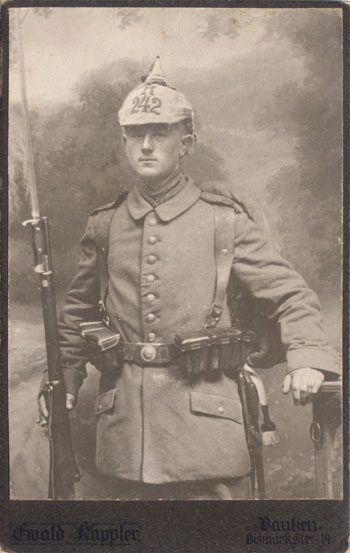
It can be assumed that (as was the norm in XXVII.RK) the NCOs were also largely drawn from the Landwehr and Landsturm. As far as officers are concerned, all three of the battalion commanders were retired or semi-retired, though RIR 242 had the considerable benefit of a peacetime regular commander - Oberstleutnant Pudor of IR 178. This was almost immediately lost in the field, as Pudor was snapped up on 21st October by the corps staff (which was trying to improvise the two infantry brigade headquarters per division which it lacked). In Pudor's temporary absence the regiment was led by the senior battalion commander, Oberstleutnant a.D. Max Hammer.
On the afternoon of 21st October RIR 242 was committed from corps reserve at the Menin Road on the extreme left of 54. RD. After several days exchanging fire with the British at Kruiseik, they were committed to an attack on the burning village on the dark and rainy evening of the 25th. According to their regimental history, the artillery preparation was wholly inadequate. Nevertheless despite suffering losses to shrapnel and machine-gun fire on the way in, the Saxons succeeded in storming a trench held by elements of 2nd Scots Guards. The village was then cleared in bitter hand to hand fighting, in which all unit cohesion was lost. Still the defenders clung on to their trenches on the village perimeter despite the threat of encirclement, and counterattacked with two fresh companies a little before 1am on the 26th. Their second attempt forced RIR 242 to abandon most of the ground it had taken, with Oberstleutnant Garten (III./242) among those killed plus (according to the British Official History) nearly 200 officers and men cut off and captured.

Above: The slow and agonising progress of the mixed Saxon / Württemberg 54. Reserve-Division up the Menin Road during the First Battle of Ypres. Although part of the purely Saxon 53. Reserve-Division, RIR 242 was committed from corps reserve to the fighting on the sister division's left flank.
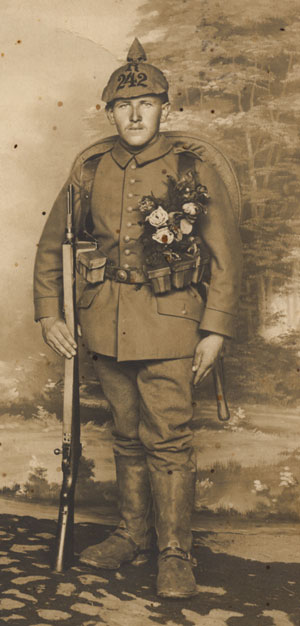
In conjunction with units of 3. Kavallerie-Division on its left, RIR 242 assaulted Kruiseik again on the morning of 26th October after a far more effective bombardment. Acting commander Oberstleutnant Hammer was among the first to die, enraging his men. The 'Lausitzer Garde' (as they would later call themselves) attacked with great aggression, and it was now the turn of the British to abandon Kruiseik in a desperate hurry. Of two companies of the 2nd Border Regt. only seventy men escaped. Two companies of 2nd Scots Guards were entirely cut off as were two platoons from a company of the Grenadier Guards, the remainder of which managed to fight their way out. The British Official History estimates a total of nine officers and 300 men captured, while in its own history RIR 242 claims to have taken more than 400 prisoners including a "regimental commander". Many of the Saxon wounded from the night before were found in the cellars of the village, having been treated chivalrously by the British. As Penther states, his regiment's losses had been grievous - though no daily figures are available. The regimental history states by the time RIR 242 was (very briefly) relieved from the battlefront on the night of 9th-10th November, its fighting strength was down from around 3000 to a mere 380 men; not as low as Penther's figure, but still horrifying.
'Harre meine Seele'
Readers may be surprised to hear that the regimental history of RIR 242 makes no mention of singing by the troops who attacked Kruseik, despite the popularity of this trope as part of the 'Legend of Langemarck' and Penther's striking eyewitness description in an account never intended for publication.
From XXVII.RK more broadly the phenomenon is certainly mentioned in 'Sachsen in Grosser Zeit' (vol.II pp.151-152), wherein Oberst z.D. Baumgarten-Crusius of RIR 245 claims that his immediate subordinate Oberstleutnant z.D. Haeser (I. Batl. / RIR 245) was the first to begin singing 'Deutschland, Deutschland über alles' during the assault on Becelaere on 20th October. He further asserts that not only Haeser's men but by implication also the other regiments participating in the assault followed his example, quoting Hermann Stegemann's 'Geschichte des Krieges' in support of his claim. Having personally taken part in the fighting on the 20th, Baumgarten-Crusius was wounded the following day and invalided out; Haeser himself was killed in action on the 23rd.
A striking difference between Penther's account and the 'Legend of Langemarck' is the choice of song - not patriotic at all, but rather purely religious. 'Harre meine Seele' is a solemn hymn expressing patient trust in God in the face of adversity (and implicitly, the face of death).
Biographical note
Curt (sometimes spelled 'Kurt') Penther was born on 4th June 1892 at Löbau in the Oberlausitz. His occupation is recorded only as 'Kaufmann' (businessman / merchant). Evidently his family was well off, as he chose the prestigious but expensive option of service as a self-financing Einjährig-Freiwilliger (one-year volunteer) in the ultimately successful hope of becoming a reserve officer. Initially trained at the barracks of Kgl. Sächs. 4. Infanterie-Regiment Nr.103 (IR 103) in Bautzen, he was part of the initial intake for the newly raised RIR 242 in August 1914.
Of the four eyewitnesses from XXVII.RK whose personal accounts of the First Battle of Ypres are featured in Fighting the Kaiser's War, three were wounded and two shot in the head - a testament to the lethal marksmanship of the experienced British regulars these hastily trained regiments were fighting. Penther survived with relatively light wounds, and was sent on an Offiziers-Aspiranten-Kursus (a training course for prospective officers), returning to the regiment in autumn 1915 with the rank of Vizefeldwebel. He soon established a formidable reputation as a fearless leader of trench raids and forward patrols, and was finally commissioned as a Leutnant der Reserve at the end of 1916. Having already been awarded the Militär St. Heinrichs-Medaille in silver as an NCO, in August 1918 Penther was honoured with the officer's Ritterkreuz of the Militär St. Heinrichs-Orden, the highest Saxon (and oldest German) order for valour:
On 24th June 1918 in the sector of the 53. Reserve-Division at Nouvron west of Soissons, the proven and dashing trench raider Leutnant Penther succeeded in penetrating 600m deep into the enemy trench system. He was forced to abandon an attempt to make off with a machine-gun in the face of strong numerical superiority following a fierce hand-grenade battle, having inflicted substantial bloody losses on the enemy.
In the early hours of 2nd July together with his assault troop he succeeded in traversing the enemy's [wire] obstacle line undetected. As the first to leap into the [enemy] trench he personally overpowered a Frenchman. He then held approaching enemy reinforcements at bay with hand grenades. Only after he knew that [all of] his men had reached safety did he return to our own trenches as the last, together with two prisoners. Leutnant Penther had already been decorated with the Militär St. Heinrichs-Medaille in silver in 1916.
He was still with RIR 242 when 53. Reserve-Division and all of its infantry regiments were disbanded in late September 1918 due to catastrophic losses, and spent the final weeks of the war with Reserve-Infanterie-Regiment Nr.103 (RIR 103).
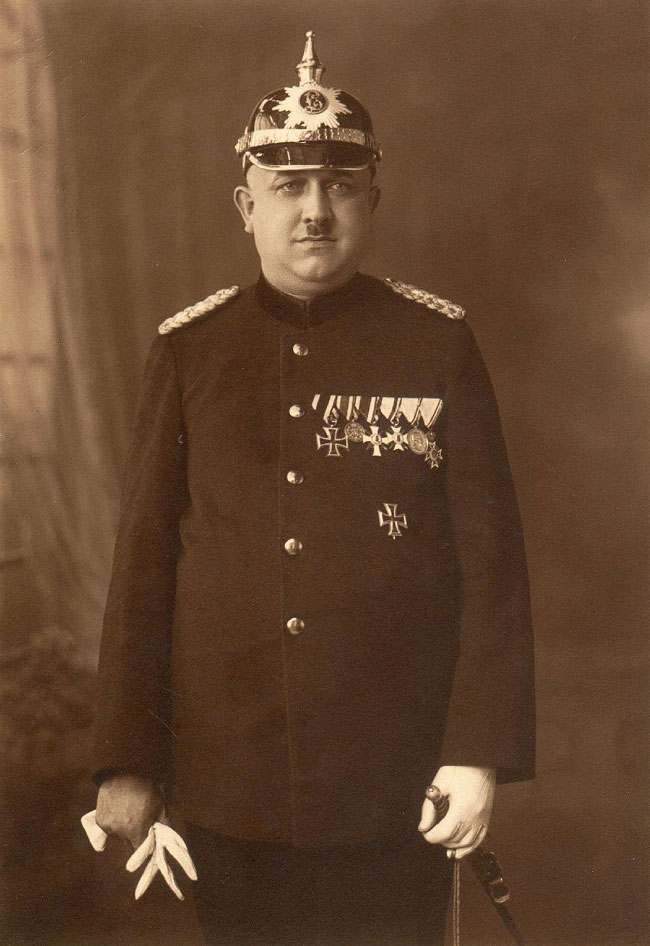
Above: Curt Penther in later life as Branddirektor (fire chief) of Löbau, wearing his impressive array of WW1 decorations.
After demobilisation Curt Penther returned to civilian life and joined the fire brigade, rising to the position of Branddirektor in Löbau. During WW2 he was recalled to service and is known to have reached the rank of Hauptmann, though his unit has not been identified.
Our primary source is a large bundle of Penther's letters to his family, acquired by Jürgen many years ago when the late officer's effects (including his medals) appeared at auction in Germany. What we know of him is derived almost entirely from these letters, supplemented by Verlustlisten and his citation for the Militär St. Heinrichs-Orden. We would be most interested to hear from anyone in possession of other parts of Penther's legacy, especially photos from his military service.

